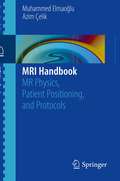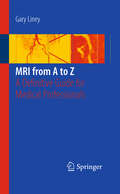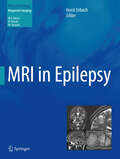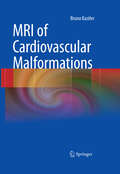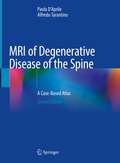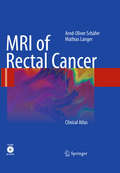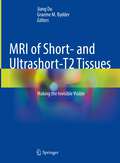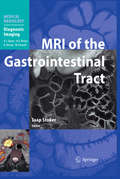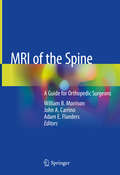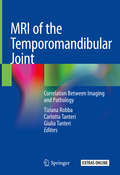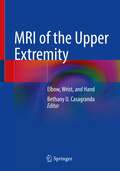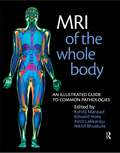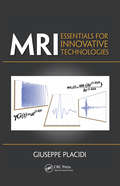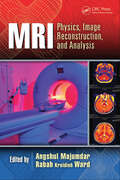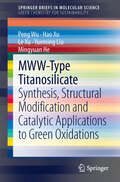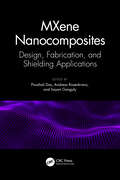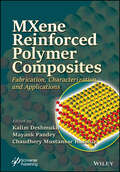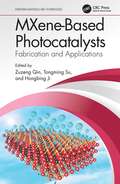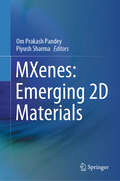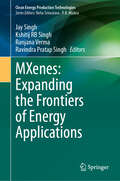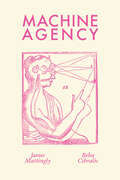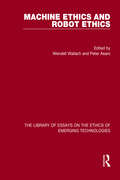- Table View
- List View
MRI Handbook
by Muhammed Elmaoğlu Azim ÇelikMRI Handbook presents a concise review of the physical principles underlying magnetic resonance imaging (MRI), explaining MR physics, patient positioning, and protocols in an easy-to-read format. The first five chapters of the book introduce the reader to the basics of MR imaging, including the relaxation concept, MR pulse sequences, and MR imaging parameters and options. The second part of the book (chapters 6-11) uses extensive illustrations, images, and protocol tables to explain tips and tricks to achieve optimal MR image quality while ensuring patient safety. Individual chapters are devoted to each major anatomic region, including the central nervous, musculoskeletal, and cardiovascular systems. By using annotated MR images and examples of patient positions used during scanning correlated with sample protocols and parameters, MRI Handbook is a practical resource for imaging professionals to use in the course of their daily practice as well as for students to learn the basic concepts of MR imaging.
MRI from A to Z
by Gary LineyThis second edition of Gary Liney's MRI from A-Z, much expanded from the first edition, is both a reflection of and an apt companion for the dramatic growth of the field of MRI. The MRI-trainee to the most seasoned practitioner in MRI will find this A-Z of the field, with 1,300 entries and 100 illustrations, an indispensable reference tool. Providing the reader with concise, clear and eloquent definitions of MRI terminology, this book is both highly practical and a pleasure to read.
MRI in Epilepsy
by Horst UrbachMRI can play an important role in identifying and localizing epileptogenic foci. This book aims to provide the clinical and imaging information required in order to decide whether an MRI scan is appropriate and whether it is likely to be sufficient to detect a lesion. The first part of the book presents background information on epilepsy patients and explains how to perform an MRI examination. Detailed attention is paid to functional MRI and post-processing, and the examination of subcategories of patients is also discussed. The second part of the book then documents the MRI findings obtained in the full range of epileptogenic lesions with the aid of high-quality images. Throughout, emphasis is placed on guiding the reader in the correct interpretation of the imaging findings. Both radiologists and referring physicians will find this book to be an indispensable guide to the optimal use of MRI in epilepsy.
MRI of Cardiovascular Malformations
by Bruno KastlerMRI is a non-invasive and non-ionizing imaging modality that is perfectly suited for the diagnosis and follow-up of both pediatric and adult congenital heart disease. It provides a large field of view and has the unique ability to depict complex cardiac and vascular anatomy and to measure cardiac function and flow within one examination. MRI is the ideal complement to echocardiography whenever the information provided by the latter is limited. This book has been conceived as a self-teaching manual that will assist qualified radiologists, cardiologists, and pediatricians, as well as those in training. It is richly illustrated with numerous images and drawings that cover all usual and most unusual anomalies. The principal author, Professor Bruno Kastler, is head of radiology at Besançon University Hospital, France and is board certified in both radiology and cardiology.
MRI of Degenerative Disease of the Spine: A Case-Based Atlas
by Paola D'Aprile Alfredo TarantinoThis is the second edition of an acclaimed, richly illustrated and comprehensive case-based atlas focusing on MRI of degenerative changes in the osteoarticular structures of the spine. Spinal degenerative disease is highly prevalent in the general population and its incidence increases with age. At the same time, degenerative spinal conditions are one of the most common causes of pain.The book presents a comprehensive overview of the MR findings observed in degenerative disease of spinal joints, ligaments and paravertebral muscles, and offers guidance on selecting the appropriate imaging protocol, which is critical in detecting the potentially very subtle changes. The MR study protocols presented include T2-weighted sequences with fat saturation and contrast-enhanced T1-weighted sequences with fat saturation, since these sequences permit better visualization of inflammatory changes of both anterior and posterior elements of the spine.This richly illustrated second edition highlights the inflammatory component of the degenerative pathology of the spine, which in most cases is responsible for the painful symptomatology. It also discusses in detail the use of contrast medium in MRI of spinal degenerative disease. The “case-based” structure of the atlas allows easy but effective consultation by radiologists, neuroradiologists, rheumatologists, orthopedists and physiatrists, as well as students.
MRI of Gynaecological Diseases: Illustrations and Cases
by Guofu ZhangThis book systematically covers MRI imaging findings of a spectrum of gynaecological diseases, including ovarian cysts, uterine fibroids, cervical cancer, and endometrial cancer, etc. All chapters are arranged in the same format: simply clinical history is firstly presented in order to help readers mimic the real clinical scenario, and then untypical features in many common diseases and typical features in many uncommon diseases are interpreted. In the end of each chapter, tips in differential diagnosis were summarized by analysing a class of cases with similar imaging performance. All cases in the book have the detailed pathological results, and the pathological specimens are also shown in some cases. It will be an ideal reference for physicians involved in the diagnosis and treatment of gynaecological diseases.
MRI of Rectal Cancer
by Mathias Langer Arnd-Oliver SchäferToday magnetic resonance imaging (MRI) of rectal cancer is one of the most interesting topics in radiology. Over the last decade technical refinements have strengthened the role of MRI as a first-line diagnostic strategy for accurate staging of rectal cancer. MRI is perfectly suited to predict tumor-free circumferential resection margins. Additionally, high accuracies have been reported for the T and N stages, which is comparable to transrectal ultrasound (TRUS). Novel approaches to moving table MRI serve as a platform for thoracic, abdominal and pelvic staging of rectal cancer patients within one examination. The broad spectrum of high-quality illustrations and the contribution of clinical experts provide substantial insight into the sophisticated field of rectal cancer management.
MRI of Short and Ultrashort-T_2 Tissues: Making the Invisible Visible
by Graeme M. Bydder Jiang DuThis book comprehensively covers ultrashort echo time (UTE), zero echo time (ZTE), and other magnetic resonance imaging (MRI) acquisition techniques for imaging of short and ultrashort-T2 tissues. MRI uses a large magnet and radio waves to generate images of tissues in the body. The MRI signal is characterized by two time constants, spin-lattice relaxation time (T1) which describes how fast the longitudinal magnetization recovers to its initial value after tipping to the transverse plane, and spin-spin relaxation time (T2) which describes how fast the transverse magnetization decays. Conventional MRI techniques have been developed to image and quantify tissues with relatively long T2s. However, the body also contains many tissues and tissue components such as cortical bone, menisci, ligaments, tendons, the osteochondral junction, calcified tissues, lung parenchyma, iron containing tissues, and myelin, which have short or ultrashort-T2s. These tissues are “invisible” with conventional MRI, and their MR and tissue properties are not measurable. UTE and ZTE type sequences resolve these challenges and make these tissues visible and quantifiable.This book first introduces the basic physics of conventional MRI as well as UTE and ZTE type MRI, including radiofrequency excitation, data acquisition, and image reconstruction. A series of contrast mechanisms are then introduced and these provide high resolution, high contrast imaging of short and ultrashort-T2 tissues. A series of quantitative UTE imaging techniques are described for measurement of MR tissue properties (proton density, T1, T2, T2*, T1p,magnetization transfer, susceptibility, perfusion and diffusion). Finally, clinical applications in the musculoskeletal, neurological, pulmonary and cardiovascular systems are described.This is an ideal guide for physicists and radiologists interested in learning more about the use of UTE and ZTE type techniques for MRI of short and ultrashort-T2 tissues.
MRI of the Gastrointestinal Tract
by Jaap StokerMRI has become an important tool in the management of patients with diseases of the gastrointestinal tract, such as rectal cancer and inflammatory bowel diseases. This book, written by distinguished experts in the field, discusses in detail the technical, practical, and clinical aspects of MRI of the gastrointestinal tract. The chapters on technique encompass the most recent developments and address such topics as contrast media, high field strength MRI, and perfusion MRI. Subsequently, individual chapters are devoted to the clinical applications of MRI in the different parts of the gastrointestinal tract. Both established applications and new frontiers are considered, with the aid of numerous high-quality illustrations. By combining chapters dedicated to technical aspects and clinically oriented chapters, this book will prove very instructive for the novice while simultaneously offering experienced practitioners further insights into the value of MRI of the gastrointestinal tract.
MRI of the Spine: A Guide for Orthopedic Surgeons
by William B. Morrison John A. Carrino Adam E. FlandersUtilizing plentiful radiological images to illustrate each topic, this text is a comprehensive and descriptive review of magnetic resonance imaging (MRI) interpretation for the spine, emphasizing standardized nomenclature and grading schemes. The book begins with current MR imaging protocols, including indication, sequencing and advanced imaging techniques, and a review of the relevant anatomy of the spine and its anomalies. Subsequent chapters encompass topics of trauma, degenerative disease, infection, inflammatory disease, as well as neoplastic and metabolic disease. Spinal cord and dural lesions will also be presented, with additional chapters dedicated to MRI evaluation of the post-operative patient. The format is reader-friendly, utilizing an efficient presentation of the essential principles and important findings on MR images of the spine, with a wealth of high-quality figures, graphics and tables for differential diagnosis as well as tips and tricks from experts in the field. Presenting the most up-to-date protocols and suggested interpretations, MRI of the Spine will be a solid reference for orthopedic surgeons, sports medicine specialists, neurosurgeons, radiologists and all clinicians and support staff caring for the spine.
MRI of the Temporomandibular Joint: Correlation Between Imaging and Pathology
by Tiziana Robba Carlotta Tanteri Giulia TanteriThis book is the outcome of a fruitful, long-standing cooperation between expert radiologists and clinicians, and explains the most relevant features and technical requirements that are needed to optimally conduct and assess MR examinations for temporomandibular joint (TMJ) pathologies. TMJ conditions are increasingly gaining attention, as the underlying diseases involved can vary considerably and be difficult to diagnose. Similarly, several imaging sub-specialties (e.g. dental radiology, neuroradiology, and musculoskeletal radiology) now find themselves dealing with the temporomandibular joints. The authors provide essential information on TMJ anatomy, dynamics, function and dysfunction. Correlations between clinical aspects and MRI findings are discussed and guidance for the correct interpretation of results is offered. Special findings that are helpful for differential diagnosis (arthritis, osteochondroma, synovial chondromatosis) are also examined. Given its extensive and varied coverage, the book offers a valuable asset for radiologists, dentists, gnathologists, maxillofacial surgeons, orthodontists and other professionals seeking a thorough overview of the subject
MRI of the Upper Extremity: Elbow, Wrist, and Hand
by Bethany U. CasagrandaThis book systematically discusses the anatomy and pathology of three specific regions of the upper extremity: the elbow, wrist, and hand. Divided into three sections, by body part, chapters cover anatomy and pathology. The anatomy chapters give a comprehensive view of each body part and normal variants found there. Although the primary modality emphasized will be MRI, illustrations and other modalities, including plain radiograph and CT, will be used to comprehensively discuss the anatomy of each region. Liberally illustrated, the pathology chapters then cover both traumatic and non-traumatic causes for imaging and detail how to perform and interpret each MRI. Specific examples include: osseous trauma, soft tissue trauma, and tumor imaging. Chapters are written with the deliberate intention to be of value to all levels of radiology training while remaining a reliable resource for attending radiologists.
MRI of the Whole Body: An Illustrated Guide for Common Pathologies
by Edward Hoey Nikhil Bhuskute Amit Lakkaraju Kshitij MankadThe optimal use of magnetic resonance imaging poses a constant challenge as the technology is continually and rapidly advancing. This leaves the MR practitioner, beginner or experienced, in constant need of up-to-date, easily read and well illustrated material presenting the clinical constellation of pathologies as seen by an MRI scanner in such an
MRI: Essentials for Innovative Technologies
by Giuseppe PlacidiMRI: Essentials for Innovative Technologies describes novel methods to improve magnetic resonance imaging (MRI) beyond its current limitations. It proposes smart encoding methods and acquisition sequences to deal with frequency displacement due to residual static magnetic field inhomogeneity, motion, and undersampling. Requiring few or no hardware
MRI: Physics, Image Reconstruction, and Analysis (Devices, Circuits, and Systems)
by Krzysztof Iniewski Angshul Majumdar Rabab Kreidieh WardThe field of magnetic resonance imaging (MRI) has developed rapidly over the past decade, benefiting greatly from the newly developed framework of compressed sensing and its ability to drastically reduce MRI scan times. MRI: Physics, Image Reconstruction, and Analysis presents the latest research in MRI technology, emphasizing compressed sensing-based image reconstruction techniques. The book begins with a succinct introduction to the principles of MRI and then: Discusses the technology and applications of T1rho MRI Details the recovery of highly sampled functional MRIs Explains sparsity-based techniques for quantitative MRIs Describes multi-coil parallel MRI reconstruction techniques Examines off-line techniques in dynamic MRI reconstruction Explores advances in brain connectivity analysis using diffusion and functional MRIs Featuring chapters authored by field experts, MRI: Physics, Image Reconstruction, and Analysis delivers an authoritative and cutting-edge treatment of MRI reconstruction techniques. The book provides engineers, physicists, and graduate students with a comprehensive look at the state of the art of MRI.
MULTIDISCIPLINARY APPROACHES FOR SUSTAINABLE DEVELOPMENT: International Conference on MULTIDISCIPLINARY APPROACHES FOR SUSTAINABLE DEVELOPMENT IN SCIENCE & TECHNOLOGY
by Monica Sharma Shilpi Birla Anshuman Tripathi Jagrati Sahariya Mamta SoniIn a world where the pace of technological advancement continues to accelerate, the imperative to ensure sustainable development has never been more pressing to address the same, the 1st International Conference on Multidisciplinary Approaches for Sustainable Development in Science & Technology (MASDST - 2024), took place at Manipal University Jaipur, Rajasthan, India, from 28th to 29th March 2024. Embracing the spirit of innovation and collaboration, this conference marks a significant milestone in the pursuit of sustainable solutions for our global challenges.
MWW-Type Titanosilicate: Synthesis, Structural Modification and Catalytic Applications to Green Oxidations
by Hao Xu Mingyuan He Yueming Liu Le Xu Peng WuThis book provides a comprehensive review of a new generation of selective oxidation titanosilicate catalysts with the MWW topology (Ti-MWW) based on the research achievements of the past 12 years. It gives an overview of the synthesis, structure modification and catalytic properties of Ti-MWW. Ti-MWW can readily be prepared by means of direct hydrothermal synthesis with crystallization-supporting agents, using dual-structure-directing agents and a dry-gel conversion technique. It also can be post-synthesized through unique reversible structure transformation and liquid-phase isomorphous substitution. The structural conversion of Ti-MWW into the materials usable for processing large molecules is summarized. Taking advantage of the structure diversity of the lamellar precursor of Ti-MWW, it can be fully or partially delaminated, and undergo interlayer silylation to obtain a novel structure with larger porosity. In the selective oxidation (alkene epoxidation and ketone/aldehyde ammoximation) with hydrogen peroxide or organic peroxide as an oxidant, the unique catalytic properties of Ti-MWW are described in comparison to conventional titanosilicates such as TS-1 and Ti-Beta.
MXene Nanocomposites: Design, Fabrication, and Shielding Applications
by Poushali Das Sayan Ganguly Andreas RosenkranzMXenes offer single step processing, excellent electrical conductivity, easy heat dissipation behavior, and capacitor-like properties and are used in photodetectors, lithium-ion batteries, solar cells, photocatalysis, electrochemiluminescence sensors, and supercapacitors. Because of their superior electrical and thermal conductivities, these composites are an ideal choice in electromagnetic interference (EMI) shielding. MXene Nanocomposites: Design, Fabrication, and Shielding Applications presents a comprehensive overview of these emerging materials, including their underlying chemistry, fabrication strategies, and cutting-edge applications in EMI shielding. • Covers modern fabrication technologies, processing, properties, nanostructure formation, and mechanisms of reinforcement. • Discuss biocompatibility, suitability, and toxic effects. • Details innovations, applications, opportunities, and future directions in EMI shielding applications. This book is aimed at researchers and advanced students in materials science and engineering and is unique in its detailed coverage of MXene-based polymer composites for EMI shielding.
MXene Reinforced Polymer Composites: Fabrication, Characterization and Applications
by Chaudhery Mustansar Hussain Kalim Deshmukh Mayank PandeyMXene Reinforced Polymer Composites This volume is the first book to comprehensively explore the various fabrication and processing strategies for MXene-reinforced polymer composites including detailed characterizations and their numerous applications. The book systematically provides a critical discussion on the synthesis and processing methods, structure, properties, characterizations, surface chemistry, and functionalization strategies of MXenes and their utilization as efficient nanofiller into various polymer matrices to form high-performance polymer composites. The book provides a deep insight into the recent state-of-the-art progress in MXene-reinforced polymer composites, discussing several critical issues and providing suggestions for future work. The key features of this book are: Providing fundamental information and a clear understanding of the synthesis, processing, compositions, structure, and physicochemical properties of MXenes; Presenting a comprehensive review of several recent accomplishments and key scientific and technological challenges in developing MXene-reinforced polymer composites; Exploring various processing and fabrication methods of MXene-reinforced polymer composites; Providing deep insight into fundamental properties and various emerging applications of MXene-reinforced polymer/composites. Audience Researchers, postgraduates, and industry engineers working in materials science, polymer science, materials engineering, and nanotechnology, as well as technologists in electronic, electrical, and biomedical industries.
MXene-Based Photocatalysts: Fabrication and Applications (Emerging Materials and Technologies)
by Zuzeng QinMXene, a two-dimensional (2D) transition metal carbide, nitride, and carbonitride, was discovered in 2011. MXene has great potential as a cocatalyst in the field of photocatalysis due to its unique properties and structure. MXene-Based Photocatalysts: Fabrication and Applications introduces readers to the fundamentals, preparation, microstructure characterization, and a variety of applications of MXene-based photocatalysts. The book is a comprehensive reference for MXene materials and provides an overview of the current literature on MXene-based photocatalysts. FEATURES Discusses preparation methods of MXenes Describes the morphology and microstructure of MXenes Offers strategies for fabricating MXene-based photocatalysts Details the reaction mechanism of MXene-based photocatalysts Covers applications in photocatalytic water-splitting, photocatalytic CO2 reduction, photocatalytic degradation, photocatalytic nitrogen fixation, and photocatalytic H2O2 production This book serves as an invaluable guide for advanced students, industry professionals, professors, and researchers in the field of materials science and engineering, photocatalysis, energy, and environmental applications.
MXenes: Emerging 2D Materials
by Piyush Sharma Om Prakash PandeyThis book focuses on the expanding market for 2D MXenes and their increasing importance in future applications. It provides a thorough understanding of MXenes and their derivatives by exploring their complex composition and chemical diversity. The book provides a thorough examination of synthesis processes, characterization methodologies, and crucial attributes, which may give significant insights for both researchers and engineers. Furthermore, the book explores diverse applications of MXenes, spanning from energy storage and catalysis to electronics and beyond, thus highlighting their vast potential in driving technological innovation. Additionally, by elucidating the current state and challenges hindering the commercialization of 2D MXenes, this resource serves as a valuable guide for navigating the path towards widespread adoption. This book is an essential resource for scientists, engineers, research researchers, and students who want to delve into the captivating realm of 2D MXenes. Its interdisciplinary approach makes it a valuable tool.
MXenes: Expanding the Frontiers of Energy Applications (Clean Energy Production Technologies)
by Ravindra Pratap Singh Kshitij Rb Singh Jay Singh Ranjana VermaThe book covers fundamental aspects, explores the synthesis, composition, and various properties of this next-generation 2D material, and provides an account of the processing and development of MXenes and MXene-based composites. This book stands out as a unique contribution, focusing on two major aspects: fundamentals and energy storage applications. It thoroughly examines notable findings and technological challenges in detail. The aim is to bridge the knowledge gap in materials science, nanotechnology, and energy storage devices. The book discusses recent developments in MXenes and MXene-based composites for energy storage, including applications in supercapacitors, hybrid-ion capacitors, batteries, point-of-care devices, hydrogen storage, nanoelectronics, catalysis, electro/photocatalysis, and biofuel devices. This book provides a complete set of knowledge about 2D materials, specifically MXenes. The book serves as an excellent reference for researchers, scientists, and engineers. Moreover, it serves as a useful guide for undergraduate, postgraduate, and Ph.D. students, as well as academicians, scientists, researchers, and industry specialists working in advanced materials science, flexible electronics, nanoelectronics, and energy storage devices.
MacMillan Science (North Carolina Edition)
by Richard H. Moyer Joanne Vasquez Jay Hackett Lucy H. DanielAn inquiry based program that introduces concepts and provides opportunities for students to work together to investigate and then communicate their ideas and discoveries to teachers and peers in Science.
Machine Agency
by James Mattingly Beba CibralicAn engaging exploration of agency that provides students with the critical tools needed to understand and participate in debates about future machines.The great promise of artificial intelligence’s evolution lives alongside an equally great anxiety. As we develop increasingly autonomous machines that do things in the world, questions about agency—distinguishing machines that can act from those that cannot—are among the thorniest we face. A concise and probing exploration of agency, this accessible textbook provides the critical, technical, and conceptual tools needed to make sense of rapid changes in what machines can do and their role in our lives. James Mattingly and Beba Cibralic begin with an examination of foundational issues: What is agency? How does it differ from mindedness, consciousness, and intelligence? Can we attribute agency to certain machines, and if so, how and why? They then examine the social and ethical implications of building ever more complex machines, including those concerning moral status and responsibility. Drawing together ideas from philosophy and computer science as well as from information theory, literature, and the history of science, Machine Agency invites students to participate thoughtfully in critical debates about future machines.• Provides a roadmap for interrogating the concept of machine agency suitable for philosophy majors and non-majors alike• Investigates the connections between developments in AI and pressing issues in analytic philosophy• Explores the social and ethical impacts of computational systems with agency Features robust end-of-chapter exercises
Machine Ethics and Robot Ethics
by Wendell Wallach and Peter AsaroOnce the stuff of science fiction, recent progress in artificial intelligence, robotics, and machine learning means that these rapidly advancing technologies are finally coming into widespread use within everyday life. Such rapid development in these areas also brings with it a host of social, political and legal issues, as well as a rise in public concern and academic interest in the ethical challenges these new technologies pose. This volume is a collection of scholarly work from leading figures in the development of both robot ethics and machine ethics; it includes essays of historical significance which have become foundational for research in these two new areas of study, as well as important recent articles. The research articles selected focus on the control and governance of computational systems; the exploration of ethical and moral theories using software and robots as laboratories or simulations; inquiry into the necessary requirements for moral agency and the basis and boundaries of rights; and questions of how best to design systems that are both useful and morally sound. Collectively the articles ask what the practical ethical and legal issues, arising from the development of robots, will be over the next twenty years and how best to address these future considerations.
